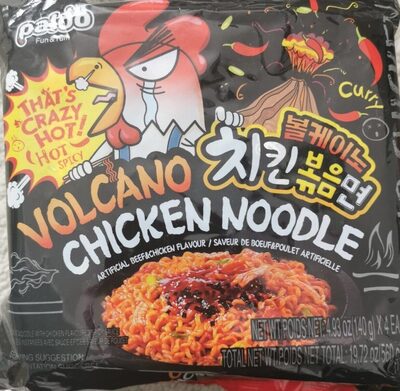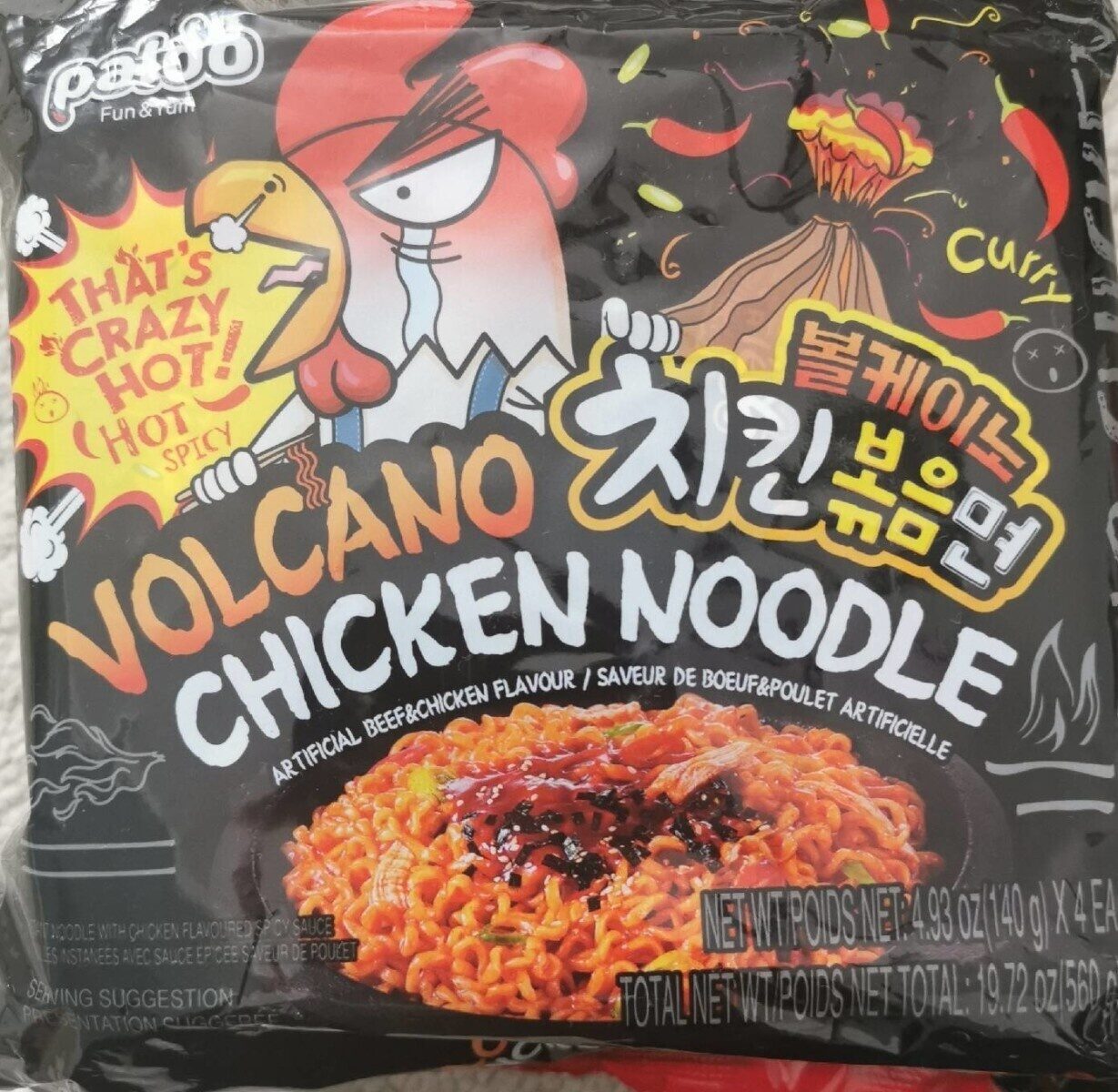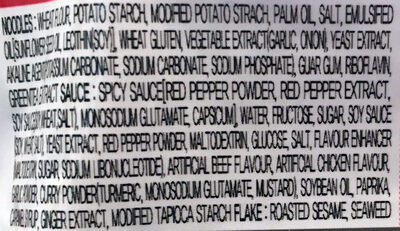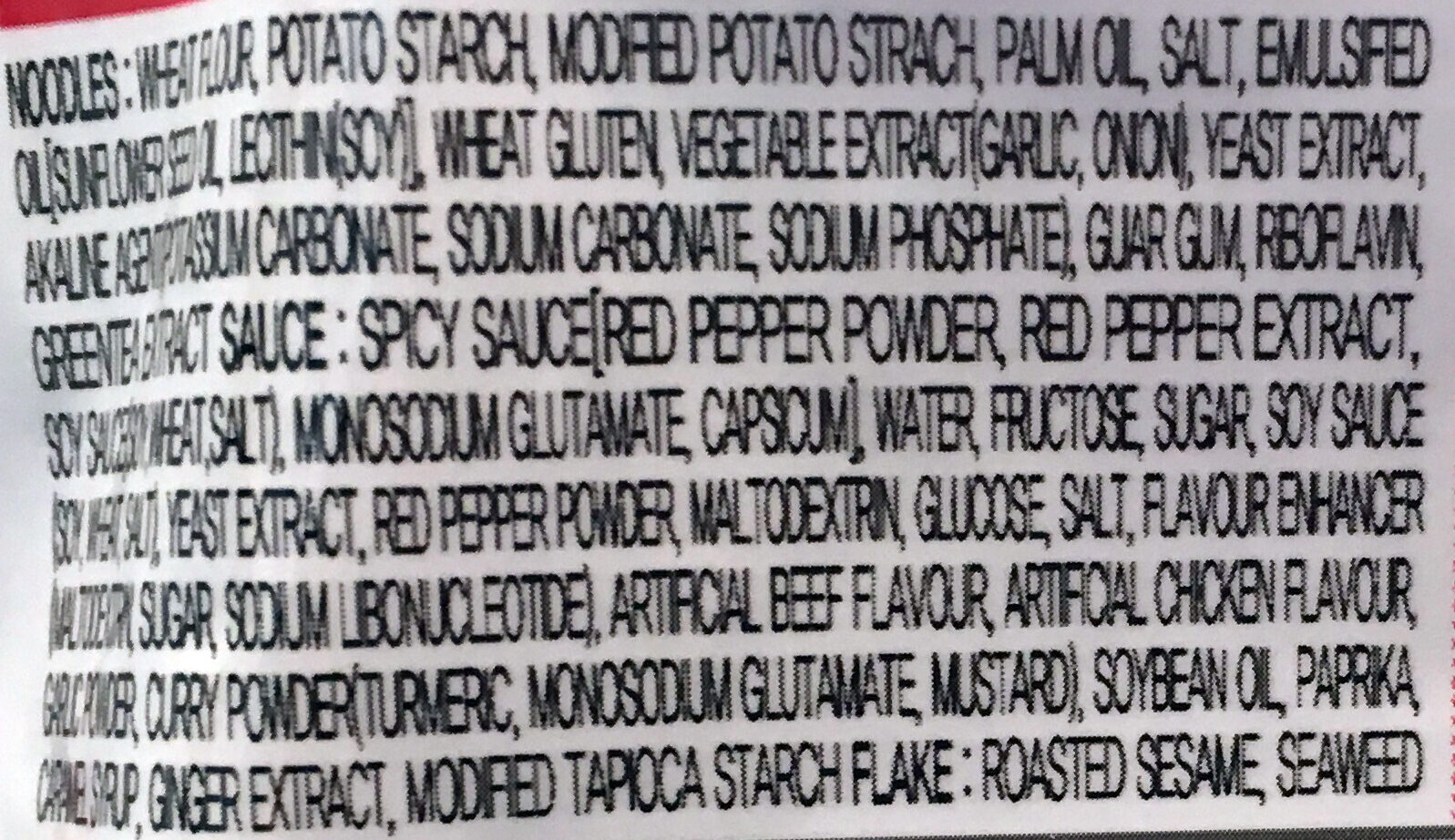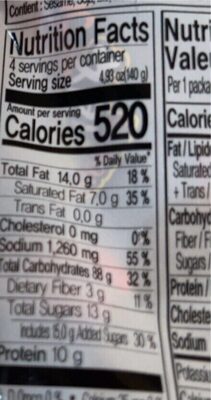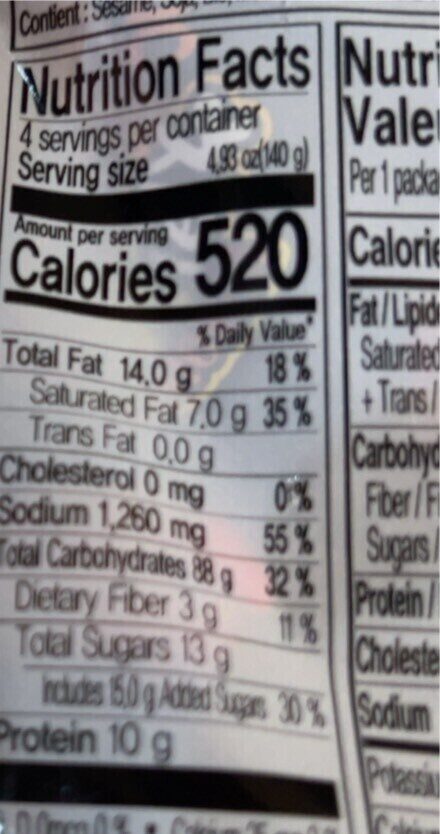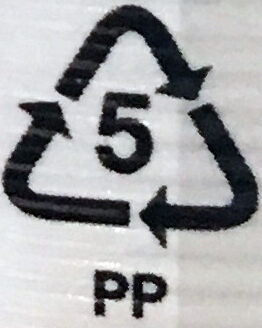Bantu kami menjadikan transparansi makanan sebagai norma!
Sebagai organisasi nirlaba, kami bergantung pada donasi Anda untuk terus memberikan informasi kepada konsumen di seluruh dunia tentang apa yang mereka makan.
Revolusi makanan dimulai dari Anda!
Nouille volcano chicken noodle - Paldo - 4 x 140 g
Nouille volcano chicken noodle - Paldo - 4 x 140 g
Halaman produk ini tidak lengkap. Anda dapat membantu melengkapinya dengan menyunting dan menambahkan lebih banyak data dari foto yang kami sediakan, atau dengan mengambil lebih banyak foto menggunakan aplikasi yang tersedia untuk Android atau iPhone/iPad. Terima kasih!
×
Kode batang: 0648436101283 (EAN / EAN-13) 648436101283 (UPC / UPC-A)
Kuantitas: 4 x 140 g
Kemasan: en:Plastic, PP
Merek - merek: Paldo
Kategori: en:Plant-based foods and beverages, en:Plant-based foods, en:Cereals and potatoes, en:Cereals and their products, en:Dried products, Pasta, en:Dried products to be rehydrated, en:Noodles, en:Instant noodles
Tempat pembuatan atau pemrosesan: Gangnam-daero, Seocho-gu, Seoul, South-Korea, Korea
Kode keterlacakan: E-VKK(US 001)
Toko: Mango Supermarked
Negara tempat dijual: Indonesia
Menyesuaikan dengan preferensi Anda
Kesehatan
bahan
-
61 bahan
Bahasa Inggris: NOODLES (WHEAT FLOUR, POTATO STARCH, MODIFIED POTATO STARCH, PALM OIL, SALT, EMULSIFIED OIL[SUNFLOWER SEED OIL, LECITHIN(SOY)], WHEAT GLUTEN, VEGETABLE EXTRACT(GARLIC,ONION), YEAST EXTRACT, ALKALINE AGENT(POTASSIUM CARBONATE, SODIUM CARBONATE, SODIUM PHOSPHATE), GUAR GUM, RIBOFLAVIN, GREEN TEA EXTRACT) SAUCE (SPICY SAUCE[RED PEPPER POWDER, RED PEPPER EXTRACT, SOY SAUCE(SOY,WHEAT,SALT), MONOSODIUM GLUTAMATE, CAPSICUM], WATER, FRUCTOSE SUGAR, SOY SAUCE(SOY,WHEAT,SALT), YEAST EXTRACT, RED PEPPER POWDER, MALTODEXTRIN, GLUCOSE, SALT, FLAVOUR ENHANCER(MALTODEXTRIN, SUGAR, SODIUM LIBONUCLEOTIDE), ARTIFICIAL BEEF FLAVOUR, ARTIFICIAL CHICKEN FLAVOUR, GARLIC, CURRY POWDER(TURMERIC, MONOSODIUM GLUTAMATE, MUSTARD), SOYBEAN OIL, PAPRIKA, CARAMEL SYRUP, GINGER EXTRACT, MODIFIED TAPIOCA STARCH) FLAKE (ROASTED SESAME, SEAWEED)Alergen - alergen: en:Gluten, en:Mustard, en:Soybeans
Pengolahan makanan
-
Makanan olahan ultra
Elemen yang menunjukkan bahwa produk berada dalam grup en:4 - Ultra processed food and drink products:
- Zat aditif: E322
- Zat aditif: E412
- Zat aditif: E621 - Mononatrium glutamat
- Bahan: Flavour enhancer
- Bahan: Glukosa
- Bahan: Gluten
- Bahan: Maltodextrin
Produk makanan diklasifikasikan ke dalam 4 kelompok sesuai dengan tingkat pengolahannya:
- Makanan - makanan yang tidak diproses atau sedikit diproses
- Bahan - bahan kuliner olahan
- Makanan olahan
- Makanan olahan ultra
Penentuan kelompok didasarkan pada kategori produk dan bahan-bahan yang dikandungnya.
Zat - zat aditif
-
E322
Lecithin: Lecithin -UK: , US: , from the Greek lekithos, "egg yolk"- is a generic term to designate any group of yellow-brownish fatty substances occurring in animal and plant tissues, which are amphiphilic – they attract both water and fatty substances -and so are both hydrophilic and lipophilic-, and are used for smoothing food textures, dissolving powders -emulsifying-, homogenizing liquid mixtures, and repelling sticking materials.Lecithins are mixtures of glycerophospholipids including phosphatidylcholine, phosphatidylethanolamine, phosphatidylinositol, phosphatidylserine, and phosphatidic acid.Lecithin was first isolated in 1845 by the French chemist and pharmacist Theodore Gobley. In 1850, he named the phosphatidylcholine lécithine. Gobley originally isolated lecithin from egg yolk—λέκιθος lekithos is "egg yolk" in Ancient Greek—and established the complete chemical formula of phosphatidylcholine in 1874; in between, he had demonstrated the presence of lecithin in a variety of biological matters, including venous blood, in human lungs, bile, human brain tissue, fish eggs, fish roe, and chicken and sheep brain. Lecithin can easily be extracted chemically using solvents such as hexane, ethanol, acetone, petroleum ether, benzene, etc., or extraction can be done mechanically. It is usually available from sources such as soybeans, eggs, milk, marine sources, rapeseed, cottonseed, and sunflower. It has low solubility in water, but is an excellent emulsifier. In aqueous solution, its phospholipids can form either liposomes, bilayer sheets, micelles, or lamellar structures, depending on hydration and temperature. This results in a type of surfactant that usually is classified as amphipathic. Lecithin is sold as a food additive and dietary supplement. In cooking, it is sometimes used as an emulsifier and to prevent sticking, for example in nonstick cooking spray.Sumber: Wikipedia (Bahasa Inggris)
-
E322i - Lesitin
Lecithin: Lecithin -UK: , US: , from the Greek lekithos, "egg yolk"- is a generic term to designate any group of yellow-brownish fatty substances occurring in animal and plant tissues, which are amphiphilic – they attract both water and fatty substances -and so are both hydrophilic and lipophilic-, and are used for smoothing food textures, dissolving powders -emulsifying-, homogenizing liquid mixtures, and repelling sticking materials.Lecithins are mixtures of glycerophospholipids including phosphatidylcholine, phosphatidylethanolamine, phosphatidylinositol, phosphatidylserine, and phosphatidic acid.Lecithin was first isolated in 1845 by the French chemist and pharmacist Theodore Gobley. In 1850, he named the phosphatidylcholine lécithine. Gobley originally isolated lecithin from egg yolk—λέκιθος lekithos is "egg yolk" in Ancient Greek—and established the complete chemical formula of phosphatidylcholine in 1874; in between, he had demonstrated the presence of lecithin in a variety of biological matters, including venous blood, in human lungs, bile, human brain tissue, fish eggs, fish roe, and chicken and sheep brain. Lecithin can easily be extracted chemically using solvents such as hexane, ethanol, acetone, petroleum ether, benzene, etc., or extraction can be done mechanically. It is usually available from sources such as soybeans, eggs, milk, marine sources, rapeseed, cottonseed, and sunflower. It has low solubility in water, but is an excellent emulsifier. In aqueous solution, its phospholipids can form either liposomes, bilayer sheets, micelles, or lamellar structures, depending on hydration and temperature. This results in a type of surfactant that usually is classified as amphipathic. Lecithin is sold as a food additive and dietary supplement. In cooking, it is sometimes used as an emulsifier and to prevent sticking, for example in nonstick cooking spray.Sumber: Wikipedia (Bahasa Inggris)
-
E412
Guar gum: Guar gum, also called guaran, is a galactomannan polysaccharide extracted from guar beans that has thickening and stabilizing properties useful in the food, feed and industrial applications. The guar seeds are mechanically dehusked, hydrated, milled and screened according to application. It is typically produced as a free-flowing, off-white powder.Sumber: Wikipedia (Bahasa Inggris)
-
E500
Sodium carbonate: Sodium carbonate, Na2CO3, -also known as washing soda, soda ash and soda crystals, and in the monohydrate form as crystal carbonate- is the water-soluble sodium salt of carbonic acid. It most commonly occurs as a crystalline decahydrate, which readily effloresces to form a white powder, the monohydrate. Pure sodium carbonate is a white, odorless powder that is hygroscopic -absorbs moisture from the air-. It has a strongly alkaline taste, and forms a moderately basic solution in water. Sodium carbonate is well known domestically for its everyday use as a water softener. Historically it was extracted from the ashes of plants growing in sodium-rich soils, such as vegetation from the Middle East, kelp from Scotland and seaweed from Spain. Because the ashes of these sodium-rich plants were noticeably different from ashes of timber -used to create potash-, they became known as "soda ash". It is synthetically produced in large quantities from salt -sodium chloride- and limestone by a method known as the Solvay process. The manufacture of glass is one of the most important uses of sodium carbonate. Sodium carbonate acts as a flux for silica, lowering the melting point of the mixture to something achievable without special materials. This "soda glass" is mildly water-soluble, so some calcium carbonate is added to the melt mixture to make the glass produced insoluble. This type of glass is known as soda lime glass: "soda" for the sodium carbonate and "lime" for the calcium carbonate. Soda lime glass has been the most common form of glass for centuries. Sodium carbonate is also used as a relatively strong base in various settings. For example, it is used as a pH regulator to maintain stable alkaline conditions necessary for the action of the majority of photographic film developing agents. It acts as an alkali because when dissolved in water, it dissociates into the weak acid: carbonic acid and the strong alkali: sodium hydroxide. This gives sodium carbonate in solution the ability to attack metals such as aluminium with the release of hydrogen gas.It is a common additive in swimming pools used to raise the pH which can be lowered by chlorine tablets and other additives which contain acids. In cooking, it is sometimes used in place of sodium hydroxide for lyeing, especially with German pretzels and lye rolls. These dishes are treated with a solution of an alkaline substance to change the pH of the surface of the food and improve browning. In taxidermy, sodium carbonate added to boiling water will remove flesh from the bones of animal carcasses for trophy mounting or educational display. In chemistry, it is often used as an electrolyte. Electrolytes are usually salt-based, and sodium carbonate acts as a very good conductor in the process of electrolysis. In addition, unlike chloride ions, which form chlorine gas, carbonate ions are not corrosive to the anodes. It is also used as a primary standard for acid-base titrations because it is solid and air-stable, making it easy to weigh accurately.Sumber: Wikipedia (Bahasa Inggris)
-
E500i - Natrium karbonat
Sodium carbonate: Sodium carbonate, Na2CO3, -also known as washing soda, soda ash and soda crystals, and in the monohydrate form as crystal carbonate- is the water-soluble sodium salt of carbonic acid. It most commonly occurs as a crystalline decahydrate, which readily effloresces to form a white powder, the monohydrate. Pure sodium carbonate is a white, odorless powder that is hygroscopic -absorbs moisture from the air-. It has a strongly alkaline taste, and forms a moderately basic solution in water. Sodium carbonate is well known domestically for its everyday use as a water softener. Historically it was extracted from the ashes of plants growing in sodium-rich soils, such as vegetation from the Middle East, kelp from Scotland and seaweed from Spain. Because the ashes of these sodium-rich plants were noticeably different from ashes of timber -used to create potash-, they became known as "soda ash". It is synthetically produced in large quantities from salt -sodium chloride- and limestone by a method known as the Solvay process. The manufacture of glass is one of the most important uses of sodium carbonate. Sodium carbonate acts as a flux for silica, lowering the melting point of the mixture to something achievable without special materials. This "soda glass" is mildly water-soluble, so some calcium carbonate is added to the melt mixture to make the glass produced insoluble. This type of glass is known as soda lime glass: "soda" for the sodium carbonate and "lime" for the calcium carbonate. Soda lime glass has been the most common form of glass for centuries. Sodium carbonate is also used as a relatively strong base in various settings. For example, it is used as a pH regulator to maintain stable alkaline conditions necessary for the action of the majority of photographic film developing agents. It acts as an alkali because when dissolved in water, it dissociates into the weak acid: carbonic acid and the strong alkali: sodium hydroxide. This gives sodium carbonate in solution the ability to attack metals such as aluminium with the release of hydrogen gas.It is a common additive in swimming pools used to raise the pH which can be lowered by chlorine tablets and other additives which contain acids. In cooking, it is sometimes used in place of sodium hydroxide for lyeing, especially with German pretzels and lye rolls. These dishes are treated with a solution of an alkaline substance to change the pH of the surface of the food and improve browning. In taxidermy, sodium carbonate added to boiling water will remove flesh from the bones of animal carcasses for trophy mounting or educational display. In chemistry, it is often used as an electrolyte. Electrolytes are usually salt-based, and sodium carbonate acts as a very good conductor in the process of electrolysis. In addition, unlike chloride ions, which form chlorine gas, carbonate ions are not corrosive to the anodes. It is also used as a primary standard for acid-base titrations because it is solid and air-stable, making it easy to weigh accurately.Sumber: Wikipedia (Bahasa Inggris)
-
E501
Potassium carbonate: Potassium carbonate -K2CO3- is a white salt, which is soluble in water -insoluble in ethanol- and forms a strongly alkaline solution. It can be made as the product of potassium hydroxide's absorbent reaction with carbon dioxide. It is deliquescent, often appearing a damp or wet solid. Potassium carbonate is used in the production of soap and glass.Sumber: Wikipedia (Bahasa Inggris)
-
E501i - Potasium karbonat
Potassium carbonate: Potassium carbonate -K2CO3- is a white salt, which is soluble in water -insoluble in ethanol- and forms a strongly alkaline solution. It can be made as the product of potassium hydroxide's absorbent reaction with carbon dioxide. It is deliquescent, often appearing a damp or wet solid. Potassium carbonate is used in the production of soap and glass.Sumber: Wikipedia (Bahasa Inggris)
-
E621 - Mononatrium glutamat
Monosodium glutamate: Monosodium glutamate -MSG, also known as sodium glutamate- is the sodium salt of glutamic acid, one of the most abundant naturally occurring non-essential amino acids. Glutamic acid is found naturally in tomatoes, grapes, cheese, mushrooms and other foods.MSG is used in the food industry as a flavor enhancer with an umami taste that intensifies the meaty, savory flavor of food, as naturally occurring glutamate does in foods such as stews and meat soups. It was first prepared in 1908 by Japanese biochemist Kikunae Ikeda, who was trying to isolate and duplicate the savory taste of kombu, an edible seaweed used as a base for many Japanese soups. MSG as a flavor enhancer balances, blends, and rounds the perception of other tastes.The U.S. Food and Drug Administration has given MSG its generally recognized as safe -GRAS- designation. A popular belief is that large doses of MSG can cause headaches and other feelings of discomfort, known as "Chinese restaurant syndrome," but double-blind tests fail to find evidence of such a reaction. The European Union classifies it as a food additive permitted in certain foods and subject to quantitative limits. MSG has the HS code 29224220 and the E number E621.Sumber: Wikipedia (Bahasa Inggris)
Analisis kandungan bahan
-
en:Palm oil
Bahan-bahan yang mengandung minyak kelapa sawit: Minyak sawit
-
en:Vegan status unknown
Bahan-bahan yang tidak dikenal: en:emulsified-oil, en:Vegetable extract, en:alkaline-agent, en:spicy-sauce, en:capsicum, en:fructose-sugar, en:sodium-libonucleotide, en:artificial-beef-flavour, en:artificial-chicken-flavour, Moster, en:Caramel syrup, en:flakeBeberapa bahan tidak dapat dikenali.
Kami membutuhkan bantuan Anda!
Anda dapat membantu kami mengenali lebih banyak bahan dan dengan lebih baik menganalisis daftar kandungan bahan untuk produk ini dan lainnya dengan:
- Sunting halaman produk ini untuk memperbaiki kesalahan ejaan dalam daftar kandungan bahan, dan/atau untuk menghapus kandungan bahan dalam bahasa dan kalimat lain yang tidak terkait dengannya.
- Tambahkan entri baru, sinonim, atau terjemahan ke daftar kandungan bahan, metode pemrosesan bahan, dan label multibahasa kami.
Bergabunglah dengan saluran #ingredients di ruang diskusi Slack kami dan/atau pelajari tentang analisis bahan di wiki kami, jika Anda ingin membantu. Terima kasih!
-
en:Vegetarian status unknown
Bahan-bahan yang tidak dikenal: en:emulsified-oil, en:Vegetable extract, en:alkaline-agent, en:spicy-sauce, en:capsicum, en:fructose-sugar, en:sodium-libonucleotide, en:artificial-beef-flavour, en:artificial-chicken-flavour, Moster, en:Caramel syrup, en:flakeBeberapa bahan tidak dapat dikenali.
Kami membutuhkan bantuan Anda!
Anda dapat membantu kami mengenali lebih banyak bahan dan dengan lebih baik menganalisis daftar kandungan bahan untuk produk ini dan lainnya dengan:
- Sunting halaman produk ini untuk memperbaiki kesalahan ejaan dalam daftar kandungan bahan, dan/atau untuk menghapus kandungan bahan dalam bahasa dan kalimat lain yang tidak terkait dengannya.
- Tambahkan entri baru, sinonim, atau terjemahan ke daftar kandungan bahan, metode pemrosesan bahan, dan label multibahasa kami.
Bergabunglah dengan saluran #ingredients di ruang diskusi Slack kami dan/atau pelajari tentang analisis bahan di wiki kami, jika Anda ingin membantu. Terima kasih!
-
Detail analisis kandungan bahan
Kami membutuhkan bantuan Anda!
Beberapa bahan tidak dapat dikenali.
Kami membutuhkan bantuan Anda!
Anda dapat membantu kami mengenali lebih banyak bahan dan dengan lebih baik menganalisis daftar kandungan bahan untuk produk ini dan lainnya dengan:
- Sunting halaman produk ini untuk memperbaiki kesalahan ejaan dalam daftar kandungan bahan, dan/atau untuk menghapus kandungan bahan dalam bahasa dan kalimat lain yang tidak terkait dengannya.
- Tambahkan entri baru, sinonim, atau terjemahan ke daftar kandungan bahan, metode pemrosesan bahan, dan label multibahasa kami.
Bergabunglah dengan saluran #ingredients di ruang diskusi Slack kami dan/atau pelajari tentang analisis bahan di wiki kami, jika Anda ingin membantu. Terima kasih!
en: NOODLES (WHEAT FLOUR, POTATO STARCH, MODIFIED POTATO STARCH, PALM OIL, SALT, EMULSIFIED OIL (SUNFLOWER SEED OIL, LECITHIN), WHEAT GLUTEN, VEGETABLE EXTRACT (GARLIC, ONION), YEAST EXTRACT, ALKALINE AGENT (POTASSIUM CARBONATE, SODIUM CARBONATE, SODIUM PHOSPHATE), GUAR GUM, RIBOFLAVIN, GREEN TEA EXTRACT), SAUCE (SPICY SAUCE (RED PEPPER, RED PEPPER, SOY SAUCE (SOY, WHEAT, SALT), MONOSODIUM GLUTAMATE, CAPSICUM), WATER, FRUCTOSE SUGAR, SOY SAUCE (SOY, WHEAT, SALT), YEAST EXTRACT, RED PEPPER, MALTODEXTRIN, GLUCOSE, SALT, FLAVOUR ENHANCER (MALTODEXTRIN, SUGAR, SODIUM LIBONUCLEOTIDE), ARTIFICIAL BEEF FLAVOUR, ARTIFICIAL CHICKEN FLAVOUR, GARLIC, CURRY (TURMERIC, MONOSODIUM GLUTAMATE, MUSTARD), SOYBEAN OIL, PAPRIKA, CARAMEL SYRUP, GINGER EXTRACT, MODIFIED TAPIOCA STARCH), FLAKE (SESAME, SEAWEED)- NOODLES -> en:noodle - vegan: maybe - vegetarian: maybe - percent_min: 33.3333333333333 - percent_max: 100
- WHEAT FLOUR -> en:wheat-flour - vegan: yes - vegetarian: yes - ciqual_proxy_food_code: 9410 - percent_min: 2.56410256410256 - percent_max: 100
- POTATO STARCH -> en:potato-starch - vegan: yes - vegetarian: yes - ciqual_proxy_food_code: 9510 - percent_min: 0 - percent_max: 50
- MODIFIED POTATO STARCH -> en:modified-potato-starch - vegan: yes - vegetarian: yes - ciqual_proxy_food_code: 9510 - percent_min: 0 - percent_max: 33.3333333333333
- PALM OIL -> en:palm-oil - vegan: yes - vegetarian: yes - from_palm_oil: yes - ciqual_food_code: 16129 - percent_min: 0 - percent_max: 25
- SALT -> en:salt - vegan: yes - vegetarian: yes - ciqual_food_code: 11058 - percent_min: 0 - percent_max: 2.25
- EMULSIFIED OIL -> en:emulsified-oil - percent_min: 0 - percent_max: 2.25
- SUNFLOWER SEED OIL -> en:sunflower-oil - vegan: yes - vegetarian: yes - from_palm_oil: no - ciqual_food_code: 17440 - percent_min: 0 - percent_max: 2.25
- LECITHIN -> en:e322i - vegan: maybe - vegetarian: maybe - percent_min: 0 - percent_max: 1.125
- WHEAT GLUTEN -> en:wheat-gluten - vegan: yes - vegetarian: yes - percent_min: 0 - percent_max: 2.25
- VEGETABLE EXTRACT -> en:vegetable-extract - percent_min: 0 - percent_max: 2.25
- GARLIC -> en:garlic - vegan: yes - vegetarian: yes - ciqual_food_code: 11000 - percent_min: 0 - percent_max: 2.25
- ONION -> en:onion - vegan: yes - vegetarian: yes - ciqual_food_code: 20034 - percent_min: 0 - percent_max: 1.125
- YEAST EXTRACT -> en:yeast-extract - vegan: yes - vegetarian: yes - ciqual_proxy_food_code: 11009 - percent_min: 0 - percent_max: 2.25
- ALKALINE AGENT -> en:alkaline-agent - percent_min: 0 - percent_max: 2.25
- POTASSIUM CARBONATE -> en:e501i - vegan: yes - vegetarian: yes - percent_min: 0 - percent_max: 2.25
- SODIUM CARBONATE -> en:e500i - vegan: yes - vegetarian: yes - percent_min: 0 - percent_max: 1.125
- SODIUM PHOSPHATE -> en:e339 - vegan: yes - vegetarian: yes - percent_min: 0 - percent_max: 0.75
- GUAR GUM -> en:e412 - vegan: yes - vegetarian: yes - percent_min: 0 - percent_max: 2.25
- RIBOFLAVIN -> en:e101 - vegan: maybe - vegetarian: yes - percent_min: 0 - percent_max: 2.25
- GREEN TEA EXTRACT -> en:green-tea-extract - vegan: yes - vegetarian: yes - ciqual_food_code: 18155 - percent_min: 0 - percent_max: 2.25
- SAUCE -> en:sauce - vegan: maybe - vegetarian: maybe - percent_min: 0 - percent_max: 50
- SPICY SAUCE -> en:spicy-sauce - percent_min: 0 - percent_max: 50
- RED PEPPER -> en:red-bell-pepper - vegan: yes - vegetarian: yes - ciqual_food_code: 20087 - percent_min: 0 - percent_max: 50
- RED PEPPER -> en:red-bell-pepper - vegan: yes - vegetarian: yes - ciqual_food_code: 20087 - percent_min: 0 - percent_max: 25
- SOY SAUCE -> en:soy-sauce - vegan: maybe - vegetarian: maybe - ciqual_food_code: 11104 - percent_min: 0 - percent_max: 16.6666666666667
- SOY -> en:soya - vegan: yes - vegetarian: yes - percent_min: 0 - percent_max: 16.6666666666667
- WHEAT -> en:wheat - vegan: yes - vegetarian: yes - ciqual_proxy_food_code: 9410 - percent_min: 0 - percent_max: 8.33333333333333
- SALT -> en:salt - vegan: yes - vegetarian: yes - ciqual_food_code: 11058 - percent_min: 0 - percent_max: 2.25
- MONOSODIUM GLUTAMATE -> en:e621 - vegan: yes - vegetarian: yes - percent_min: 0 - percent_max: 12.5
- CAPSICUM -> en:capsicum - percent_min: 0 - percent_max: 10
- WATER -> en:water - vegan: yes - vegetarian: yes - ciqual_food_code: 18066 - percent_min: 0 - percent_max: 25
- FRUCTOSE SUGAR -> en:fructose-sugar - percent_min: 0 - percent_max: 16.6666666666667
- SOY SAUCE -> en:soy-sauce - vegan: maybe - vegetarian: maybe - ciqual_food_code: 11104 - percent_min: 0 - percent_max: 12.5
- SOY -> en:soya - vegan: yes - vegetarian: yes - percent_min: 0 - percent_max: 12.5
- WHEAT -> en:wheat - vegan: yes - vegetarian: yes - ciqual_proxy_food_code: 9410 - percent_min: 0 - percent_max: 6.25
- SALT -> en:salt - vegan: yes - vegetarian: yes - ciqual_food_code: 11058 - percent_min: 0 - percent_max: 2.25
- YEAST EXTRACT -> en:yeast-extract - vegan: yes - vegetarian: yes - ciqual_proxy_food_code: 11009 - percent_min: 0 - percent_max: 10
- RED PEPPER -> en:red-bell-pepper - vegan: yes - vegetarian: yes - ciqual_food_code: 20087 - percent_min: 0 - percent_max: 8.33333333333333
- MALTODEXTRIN -> en:maltodextrin - vegan: yes - vegetarian: yes - percent_min: 0 - percent_max: 7.14285714285714
- GLUCOSE -> en:glucose - vegan: yes - vegetarian: yes - ciqual_proxy_food_code: 31016 - percent_min: 0 - percent_max: 6.25
- SALT -> en:salt - vegan: yes - vegetarian: yes - ciqual_food_code: 11058 - percent_min: 0 - percent_max: 2.25
- FLAVOUR ENHANCER -> en:flavour-enhancer - percent_min: 0 - percent_max: 2.25
- MALTODEXTRIN -> en:maltodextrin - vegan: yes - vegetarian: yes - percent_min: 0 - percent_max: 2.25
- SUGAR -> en:sugar - vegan: yes - vegetarian: yes - ciqual_proxy_food_code: 31016 - percent_min: 0 - percent_max: 1.125
- SODIUM LIBONUCLEOTIDE -> en:sodium-libonucleotide - percent_min: 0 - percent_max: 0.75
- ARTIFICIAL BEEF FLAVOUR -> en:artificial-beef-flavour - percent_min: 0 - percent_max: 2.25
- ARTIFICIAL CHICKEN FLAVOUR -> en:artificial-chicken-flavour - percent_min: 0 - percent_max: 2.25
- GARLIC -> en:garlic - vegan: yes - vegetarian: yes - ciqual_food_code: 11000 - percent_min: 0 - percent_max: 2.25
- CURRY -> en:curry - vegan: yes - vegetarian: yes - ciqual_food_code: 11005 - percent_min: 0 - percent_max: 2.25
- TURMERIC -> en:turmeric - vegan: yes - vegetarian: yes - ciqual_proxy_food_code: 11089 - percent_min: 0 - percent_max: 2.25
- MONOSODIUM GLUTAMATE -> en:e621 - vegan: yes - vegetarian: yes - percent_min: 0 - percent_max: 1.125
- MUSTARD -> en:mustard - ciqual_food_code: 11013 - percent_min: 0 - percent_max: 0.75
- SOYBEAN OIL -> en:soya-oil - vegan: yes - vegetarian: yes - from_palm_oil: no - ciqual_food_code: 17420 - percent_min: 0 - percent_max: 2.25
- PAPRIKA -> en:paprika - vegan: yes - vegetarian: yes - ciqual_food_code: 11049 - percent_min: 0 - percent_max: 2.25
- CARAMEL SYRUP -> en:caramel-syrup - percent_min: 0 - percent_max: 2.25
- GINGER EXTRACT -> en:ginger-extract - vegan: yes - vegetarian: yes - ciqual_food_code: 11074 - percent_min: 0 - percent_max: 2.25
- MODIFIED TAPIOCA STARCH -> en:modified-tapioca-starch - vegan: yes - vegetarian: yes - ciqual_proxy_food_code: 9510 - percent_min: 0 - percent_max: 2.25
- SPICY SAUCE -> en:spicy-sauce - percent_min: 0 - percent_max: 50
- FLAKE -> en:flake - percent_min: 0 - percent_max: 33.3333333333333
- SESAME -> en:sesame - vegan: yes - vegetarian: yes - ciqual_food_code: 15010 - percent_min: 0 - percent_max: 33.3333333333333
- SEAWEED -> en:seaweed - vegan: yes - vegetarian: yes - ciqual_proxy_food_code: 20984 - percent_min: 0 - percent_max: 16.6666666666667
kandungan nutrisi
-
Informasi nilai gizi
Informasi nilai gizi Seperti yang dijual
untuk 100 g / 100 mlSeperti yang dijual
per sajian (140g)Dibandingkan dengan: en:Instant noodles Energi 1.548 kj
(371 kcal)2.170 kj
(520 kcal)-7% Lemak 10 g 14 g -37% Lemak jenuh 5 g 7 g -35% Lemak tak jenuh 3,8 g 5,32 g Polyunsaturated fat 1,2 g 1,68 g Lemak trans 0 g 0 g Kolesterol 0 mg 0 mg Karbohidrat 62,857 g 88 g +13% Gula 9,286 g 13 g +47% Serat Pangan 2,143 g 3 g -32% Protein 7,143 g 10 g -11% Garam 2,25 g 3,15 g +57% Kalsium 250 mg 350 mg Fruits‚ vegetables‚ nuts and rapeseed‚ walnut and olive oils (estimate from ingredients list analysis) 10,858 % 10,858 %
Lingkungan
-
Eco-Score C - Dampak lingkungan sedang
⚠ ️Dampak penuh transportasi ke negara Anda saat ini belum diketahui.Eco-Score adalah skor eksperimental yang merangkum dampak lingkungan dari produk makanan.→ Eco-Score pada awalnya dikembangkan untuk Perancis dan sedang diperluas ke negara - negara Eropa lainnya. Formula Eco-Score dapat berubah sewaktu - sewaktu karena ia secara reguler ditingkatkan agar penghitungannya lebih presisi dan lebih cocok untuk setiap negara.Analisis siklus hidup
-
Dampak rata - rata produk dari kategori yang sama: A (Score: 82/100)
Kategori: Asian noodles, flavoured, dehydrated
Kategori: Asian noodles, flavoured, dehydrated
- Skor lingkungan PEF: 0.26 (semakin rendah skor, semakin rendah dampaknya)
- termasuk dampak terhadap perubahan iklim: 1.66 kg CO2 eq/kg produk
Tahap Dampak Pertanian
65.2 %Memproses
20.8 %Kemasan
8.7 %Transportasi
3.5 %Distribusi
1.8 %Konsumsi
0.0 %
Bonus dan penalti
-
Informasi asal usul bahan tidak ada
Penalti:
⚠ ️ Asal -usul bahan produk ini tidak disebutkan.
Jika mereka ditunjukkan pada kemasan, Anda bisa memodifikasi lembar produk dan menambahkannya.
Jika Anda adalah produsen produk ini, Anda bisa mengirimkan kami informasinya dengan platform gratis bagi produsen kami.
-
Bahan-bahan yang mengancam spesies
Penalti: -10
Mengandung minyak sawit
Hutan tropikal di Asia, Afrika dan Amerika Latin dihancurkan untuk membuat dan memperluas perkebunan pohon kelapa sawit. Deforestasi berkontribusi terhadap perubahan iklim, dan ia membahayakan spesies seperti orangutan, gajah kerdil, dan badak Sumatera.
-
Kemasan dengan dampak tinggi
Penalti: -15
Bentuk Material Mendaur ulang Dampak 1 Wrapper PP Recycle with plastics Tinggi 4 Wrapper 90 C/X Discard Tinggi 4 Individual bag 07 OTHER Discard Tinggi 4 Individual bag 07 OTHER Discard Tinggi ⚠ ️ Informasi tentang kemasan produk ini tidak cukup tepat (bentuk dan material tepat dari semua komponen kemasan).⚠ ️ Untuk penghitungan Eco-Score yang lebih tepat, Anda bisa memodifikasi halaman produk dan menambahkan nya.
Jika Anda adalah produsen produk ini, Anda bisa mengirimkan kami informasinya dengan platform gratis bagi produsen kami.
Eco-Score untuk produk ini
-
Dampak untuk produk ini: C (Score: 52/100)
Produk: Nouille volcano chicken noodle - Paldo - 4 x 140 g
Skor analisis siklus hidup: 82
Jumlah bonus dan penalti: -25
Skor akhir: 52/100
-
Jejak karbon
-
Sama dengan mengendarai 0.9 km dalam sebuah mobil berbahan bakar bensin
166 g CO² per 100g produk
Angka emisi karbon berasal dari basis data Agribalyse ADEME, untuk kategori tersebut: Asian noodles, flavoured, dehydrated (Sumber: Basis Data Agribalyse ADEME)
Tahap Dampak Pertanian
60.9 %Memproses
14.9 %Kemasan
16.3 %Transportasi
6.9 %Distribusi
1.0 %Konsumsi
0.0 %
Kemasan
-
Kemasan dengan dampak tinggi
-
Bagian kemasan
4 x Wrapper 1 (90 C/X: 3.4 g)
4 x Individual bag (07 OTHER: 2.6 g)
4 x Individual bag (07 OTHER: 0.8 g)
1 x Wrapper 4 (PP: 7.3 g)
-
Bahan kemasan
Material % Berat kemasan Berat kemasan per 100 g produk Plastic 60.6% 20.9 g 3.7 g
-
Transportasi
-
Asal-usul bahan
Informasi asal usul bahan tidak ada
⚠ ️ Asal -usul bahan produk ini tidak disebutkan.
Jika mereka ditunjukkan pada kemasan, Anda bisa memodifikasi lembar produk dan menambahkannya.
Jika Anda adalah produsen produk ini, Anda bisa mengirimkan kami informasinya dengan platform gratis bagi produsen kami.Tambahkan asal bahan untuk produk ini Tambahkan asal bahan untuk produk ini
Spesies terancam
-
Mengandung minyak sawit
Mendorong deforestasi dan mengancam spesies seperti orangutan
Hutan tropikal di Asia, Afrika dan Amerika Latin dihancurkan untuk membuat dan memperluas perkebunan pohon kelapa sawit. Deforestasi berkontribusi terhadap perubahan iklim, dan ia membahayakan spesies seperti orangutan, gajah kerdil, dan badak Sumatera.
Report a problem
-
Incomplete or incorrect information?
Category, labels, ingredients, allergens, nutritional information, photos etc.
If the information does not match the information on the packaging, please complete or correct it. Open Food Facts is a collaborative database, and every contribution is useful for all.
Sumber - sumber data
Produk - produk ditambahkan pada oleh openfoodfacts-contributors
Penyuntingan terakhir halaman produk pada oleh odinh.
Halaman produk juga disunting oleh ecoscore-impact-estimator, foodless, halal-app-chakib, kiliweb, mondetactica, packbot, yuka.LuxnFdCGBcg5OMqIy5kUhRqHN8ncD6J7BFMoog, yuka.sY2b0xO6T85zoF3NwEKvlkVgWcPQgCnYCRn6tXKbwOqXccbyYdxQ7NH1DKs, yuka.sY2b0xO6T85zoF3NwEKvlmx6SeaGsiPrKwzlx2m3x4iBFoTkRvpJ_Kz6HKs.
